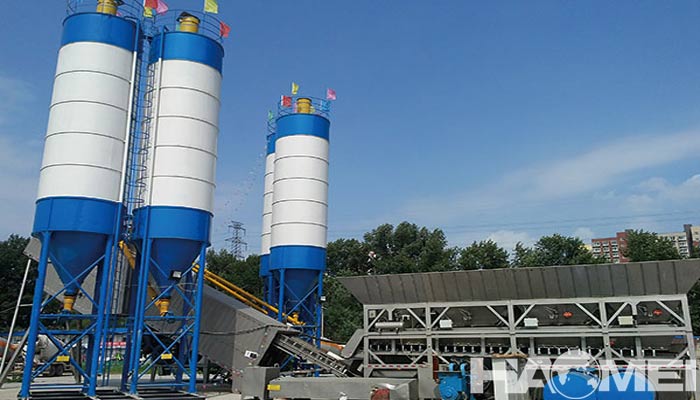Stationary Ready Mix Concrete Batching Plant
Writer:Admin Time:25/10/24A stationary ready mix concrete batching plant is a complete set of equipment designed specifically for large-scale concrete production. It features a high degree of automation, stable production efficiency, and strict quality control, so is widely used in construction, road and bridge construction, water conservancy and hydropower projects.

Key System Configuration of Stationary Ready Mix Concrete Batch Plant:
A typical stationary concrete batching plant (such as the HZS120) includes the following modules:
Mixing System: Utilizes a JS2000 twin-shaft forced concrete mixer with a 2×37kW motor, a 23 rpm mixing shaft speed, a single mixing volume of 2000L, and a theoretical production rate of 120 cubic meters per hour.
Batching System: The PLD3200 batching machine supports independent metering of aggregates in four bins and is equipped with high-precision sensors, ensuring metering errors within ±1%.
Conveying System: A belt conveyor transports aggregates, while a screw conveyor transports powder materials (cement and fly ash). These conveying systems offer high efficiency and strong sealing.
Control System: Fully automated computer control supports one-touch start, mix ratio storage, fault diagnosis, and other functions, and can be connected to an IoT platform for remote monitoring.
Storage System: Four 50-200 ton cement silos are standard, equipped with built-in level meters and arch-breaking devices to ensure a stable supply of powder.
Flexible Customization Capabilities: The equipment configuration can be adjusted according to needs, for example:
Upgrading to a 4800L mixer increases production capacity to 240 cubic meters per hour;
Adding an admixture metering tank meets the production needs of high-performance concrete (such as C60 and above);
Equipped with a fully enclosed aggregate silo and a spray dust suppression system to meet environmental requirements.
The standardized production process, from raw materials to finished concrete, involves the following steps:
- Aggregate Loading:
A loader delivers sand and gravel aggregates into the batching machine silo, where they are accurately metered using a belt scale.
- Powder Conveying:
Cement and fly ash are transported from the silos to the powder scale via a screw conveyor, where they are independently metered before entering the concrete mixer.
- Liquid Metering:
Water and admixtures are pumped to a liquid scale via a centrifugal pump, achieving both coarse and fine weighing control.
- Mixing Process:
Dry mix for 10-15 seconds to evenly coat the powder with the aggregate, then add liquid for a wet mix of 30-60 seconds to ensure concrete homogeneity.
- Discharging and Loading:
Finished concrete is loaded directly into a concrete mixer truck through the discharge hopper for transportation to the construction site.
Operational Safety Tips
Operators must be certified and familiar with the equipment's operating procedures and emergency response procedures.
Calibrate the metering system regularly (at least weekly), using standard weights to verify the accuracy of the aggregate scale (error ≤±2%) and the powder scale (error ≤±1%).
Do not open the maintenance door while the main mixer is operating. When cleaning residual concrete in the tank, disconnect the power cord and have dedicated personnel on duty.
During thunderstorms, check the lightning protection grounding system; the grounding resistance should be ≤4Ω.
Typical Application Areas of Stationary Ready Mix Concrete Batch Plant
- Infrastructure Construction:
Projects such as highways, railways, bridges, and tunnels. For example, the Moscow-Kazan High-Speed Railway project in Russia uses an HZS120 concrete batching plant to supply C50 concrete.
- Ready-Mixed Concrete Plant Operations:
Providing commercial concrete for urban construction projects. For example, the Kuala Lumpur City Complex project in Malaysia boasts a daily production capacity exceeding 2,000 cubic meters.
- Specialty Concrete Production:
Hydraulic Concrete (impermeability P8 and above), Marine Concrete (chloride ion resistant), and Self-Compacting Concrete require precise admixture metering systems.
Stationary ready mix concrete batching plants, with their high efficiency, stability, and environmental friendliness, have become core equipment in modern construction industrialization. When selecting a model, companies should comprehensively consider project requirements, policy requirements, and supplier capabilities, while also prioritizing green and intelligent upgrades to meet industry competition and sustainable development challenges.
- Previous:A Concrete Batch Mix Plant - HZS50...
- Next:Automatic Concrete Batching Plants...

